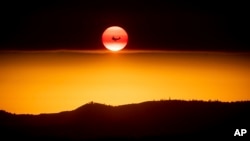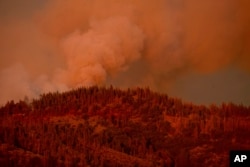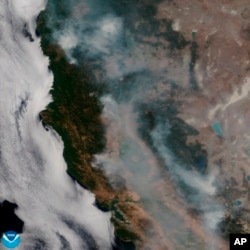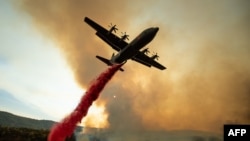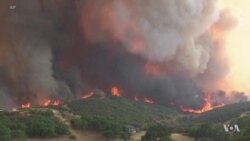A day after California authorities said a wildfire in Northern California had become the largest in the state's recorded history, officials gave the state's residents more bad news: The wildfire raging around Yosemite National Park will close it and the Yosemite Valley for the foreseeable future.
The Ferguson Fire has been burning in and around Yosemite National Park for nearly a month, impacting three of the park's entrances. National Park Service officials said they did not know when the park would reopen.
The fire hasn't reached the valley yet, but the smoke has reached hazardous pollution levels, park officials said, forcing the closure.
Yosemite spokesman Scott Gediman said the fires have had a huge "economic impact" on the area during its busiest tourist season. While fire officials are hoping to "get the park open as soon as it is safe to do so," Gediman said, the growing wildfire is making it "a day-to-day situation."
Late Monday, authorities in California said a wildfire that began burning more than a week ago has become the largest in the state's recorded history.
The blaze, known as the Mendocino Complex Fire, is made up of two separate fires in the northern part of the state that have merged and by Tuesday had collectively burned 1,178 square kilometers — an area nearly the size of the city of Los Angeles.
The California Department of Forestry and Fire Protection (CAL FIRE) said the fire was only 34 percent contained and was still growing. The flames have so far destroyed about 150 structures, mainly because it is burning in remote areas.
Tens of thousands of people have been forced from their homes. More than 14,000 firefighters have been deployed to battle the 17 wildfires now burning in the state, state Department of Forestry and Fire Protection spokesman Scott McLean said.
Doreen Gatewood, a fire information officer working on the Mendocino Complex Fire, told VOA no one had been killed in the blaze. She said conditions such as high temperatures, low humidity and heavy wind have persisted in the area, allowing the fire to reach such a massive size.
Nearly 4,000 personnel are working to put out the fire, including crews flying helicopters and planes to drop fire suppressant from above.
CAL FIRE estimated it could bring the fire under control by the middle of next week.
Similar environmental conditions have also contributed to the growth of the Carr Fire, also in the northern part of California. That fire, the 12th-largest ever recorded in the state, has proved far deadlier, killing five civilians and two firefighters.
WATCH: Heat wave
Meanwhile, a new fire erupted south of Los Angeles in Orange County late Monday and quickly spread through the chaparral-covered ridges of the Cleveland National Forest.
On Monday, Lynne Tolmachoff, a spokeswoman for CAL FIRE, told The New York Times the state has "a long road ahead," as it is in the middle of its fire season. Worse fire conditions occur later in the year, she said.
On Sunday, President Donald Trump declared a state of emergency for the area, paving the way for increased federal assistance in fighting the fire.
Allie Weill, a fire behavior researcher at the University of California-Davis, told VOA that in recent years the climate conditions that make such large fires possible have been present earlier and longer in the state.
"This is part of a trend, the new normal, that we've got to deal with," California Governor Jerry Brown said.




